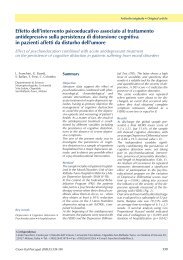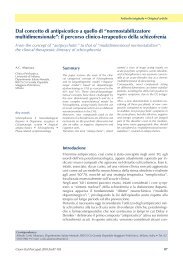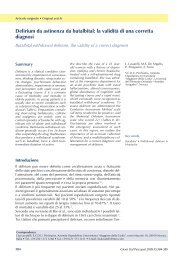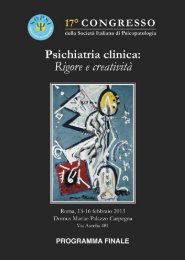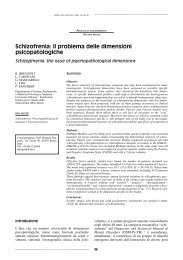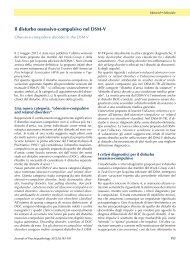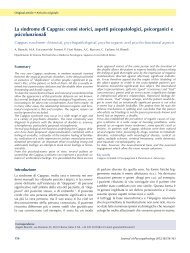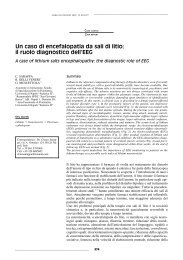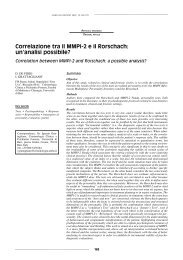XI Congresso della Società Italiana di Psicopatologia Psichiatria ...
XI Congresso della Società Italiana di Psicopatologia Psichiatria ...
XI Congresso della Società Italiana di Psicopatologia Psichiatria ...
Create successful ePaper yourself
Turn your PDF publications into a flip-book with our unique Google optimized e-Paper software.
teria and having a history no compliance. The mean quetiapine<br />
dose was 300 mg/day and 600 mg/day. Psychiatric <strong>di</strong>sorders<br />
were evaluated by a semi-structured interview inclu<strong>di</strong>ng<br />
the Structured Clinical Interview for DSM-IV Axis I (SCID-<br />
I) and Personality Disorders (SCID-II).<br />
The patients were assessed for Psychotic symptoms with the<br />
Positive and Negative Syndrome Scale (PANSS); for depressive<br />
symptoms with HAMD and MADRS; with Psychiatric<br />
Rating Scale (BPRS) and CGI; for other symptoms<br />
with HAMA, SCL-90; for obsessive-compulsive symptomatology<br />
was detected accor<strong>di</strong>ng to the italian version of<br />
the Leyton Obsessional Inventory; for adverse events (AEs)<br />
were reported spontaneously.<br />
Assessment: at baseline and at week 12 of quetiapine treatment;<br />
Quetiapine was added to other me<strong>di</strong>cations, but other<br />
antipsychotics.<br />
Results: there was a significant effect of treatment on improvement<br />
in PANSS total scores from baseline to endpoint<br />
for patients with <strong>di</strong>agnosis Cluster A and Cluster B personality<br />
<strong>di</strong>sorders (72% reduction of positive symptoms in the<br />
PANSS positive subscale and negative symptoms 54% reduction<br />
of negative symptoms in the PANSS negative subscale;<br />
p = 0.001).<br />
The reduction in HAMDscores between the baseline (24.6 ±<br />
2.1) and the endpoint (5.0 ± 2.0) was statistically significant<br />
(p = 0.002). The reduction in HAMAscores between the<br />
baseline (25.6 ± 4.1) and the endpoint (4.0 ± 2.0) was statistically<br />
significant (p = 0.001). The most commonly observed<br />
side effects included asthenia (8 patients, 32%),<br />
weight gain (4 patients, 16%), and mild sedation (6 patients,<br />
24%). Marked improvement in CGI after 12 week of treatment<br />
was observed in 19 (76%) patients (8 patients, 32%<br />
Cluster A; 9 patients, 36% Cluster B; 2 patients, 8% Cluster<br />
C Personality Disorder).<br />
Conclusions: this study suggests that quetiapine may be an<br />
effective and well tolerated drug for treatment cluster A and<br />
Cluster B personality <strong>di</strong>sorders.<br />
67. Anxiety and dental implantology:<br />
symptoms anxious and outcome in<br />
implantology. (At the private dental office)<br />
P. Cimmino * , C. Cimmino, G. Palmigiano **<br />
Psychiatry Emergency Hospital, Frattaminore, ASL Napoli<br />
3, Napoli; * Private Implantology Dental Center, Napoli;<br />
** University of Napoli, Federico II<br />
Objective: the study aimed to evaluate the anxious symptoms<br />
associated with dental implantology on 16 cases in a<br />
private dental office<br />
Methods: at this study was recruited a sample of 16 cases<br />
awaiting dental implants (peri-implant soft tissue health status<br />
of implants supporting overdentures with bar attachments<br />
in the man<strong>di</strong>ble; 16 cases = 43 implants). The sample was assessed<br />
by work’s group of the Center for the study of Anxiety<br />
and Depression Disorder of the Psychiatry Emergency Hospital<br />
“San Giovanni <strong>di</strong> Dio” Frattaminre (Napoli) to exclude<br />
a DSM-IV <strong>di</strong>agnosis of Anxiety and Depression Disorder.<br />
At baseline, before surgery, the sample was evaluated with<br />
instruments: PAAAS, HAM-A, SCL-90, that estimated re-<br />
255<br />
POSTER<br />
spectivily the symptomatologic gravity and anxious characteristics.<br />
The sample was <strong>di</strong>vided in two groups on the basis of presence<br />
[A-AN<strong>XI</strong>ETY-: n° 9 (56.25%), 8 female = 50% and 1<br />
male = 6.25%] or absence [NA-NO AN<strong>XI</strong>ETY-: n° 7<br />
(43.75%), 2 females = 12.5% e 5 males = 31,25] of presurgical<br />
anxiety.<br />
The aforementioned factor(anxiety) was evaluated<br />
(PAAAS, HAMA, SCL-90) imme<strong>di</strong>ately after surgery, at 24<br />
hours, and during a follow-up for a period of 1 year at intervals<br />
of week; 1,2,3,4, and 6 months, and 1 year after.<br />
All of implants were placed and evaluated by same clinician.<br />
Dental implant clinical aspects postsurgical were evaluated<br />
with a descriptive scale of five items on dental area and<br />
ridges.<br />
Results: the results of statistical analysis in<strong>di</strong>cate a correlation<br />
between anxiety and negative outcome in dental implantology,<br />
in a private dental practice, at the level of significance<br />
p = 0.002.<br />
Conclusion: after an extensive review of dental literature,<br />
few articles were found related to anxiety and implantology.<br />
In this preliminary study, the group A with anxious symptoms<br />
results characterized during follow-up 1years by higher<br />
level of pain in the implanted area, neuralgia, edema,<br />
headaches, pain during mastication, speech, opening, closing,<br />
pain of the area of pterygoid and masseter muscles, intellectual<br />
<strong>di</strong>sorders: memory and concetration deficit.<br />
Anxiety could represent negative pre<strong>di</strong>ctor of outcome in<br />
higher level of symptomatologic severity postsurgical and<br />
greater expression late remission in dental implantology.<br />
68. Il corpo come espressione <strong>di</strong> <strong>di</strong>sagio<br />
psichico: <strong>di</strong>verse modalità <strong>di</strong> comunicazione<br />
M.E. Cinti, R. De Bellis, S. De Nitto, C. Tilocca, M. Di<br />
Giusto<br />
Dipartimento Scienze Psichiatriche e Me<strong>di</strong>cina Psicologica,<br />
Università <strong>di</strong> Roma “La Sapienza”<br />
Introduzione: all’interno dei “significati psicologici” del<br />
corpo, non c’è dubbio che il suo valore espressivo, come<br />
strumento <strong>di</strong> comunicazione, sia tra i più pregnanti. Questa<br />
<strong>di</strong>mensione si propone anche in psicopatologia, quando il<br />
<strong>di</strong>sagio psichico non può essere verbalizzato e viene manifestato<br />
attraverso sintomi somatici. Ma il processo <strong>di</strong> somatizzazione<br />
si può organizzare a <strong>di</strong>versi livelli, con <strong>di</strong>verse<br />
<strong>di</strong>namiche e conseguentemente con <strong>di</strong>versi orientamenti terapeutici.<br />
Metodologia: le osservazioni si riferiscono due gruppi <strong>di</strong><br />
soggetti: 30 con sintomatologie somatiche che al colloquio<br />
clinico potevano essere interpretate come sintomi <strong>di</strong> conversione,<br />
e 30 con sintomatologie somatiche che non si configuravano<br />
come <strong>di</strong>sturbi <strong>di</strong> conversione. I soggetti, afferenti<br />
alla UOC <strong>di</strong> Psicologia Clinica del Policlinico Umberto I,<br />
sono stati sottoposti ad esame <strong>di</strong>agnostico me<strong>di</strong>ante reattivi<br />
mentali, quali il test <strong>di</strong> autovalutazione MMPI-2 ed il test<br />
proiettivo DFU.<br />
Risultati: è stata effettuata un’ANOVA per valutare le <strong>di</strong>fferenze<br />
fra gruppi e una correlazione fra le scale dei reattivi<br />
usati.




